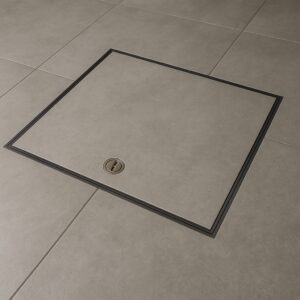
When you’re designing a space that needs to be both functional and visually clean, it’s often the little details that make the biggest difference. One of those details? How you access the areas beneath your floors.
If the words “floor hatch” bring to mind clunky metal covers or disruptive raised edges, it’s time to rethink what’s possible. Recessed floor hatches have quietly become a game-changer in modern construction and renovation. They’re practical, yes, but also incredibly effective at keeping floors seamless and stylish.
What Makes a Hatch Recessed?
Recessed floor access hatches are designed to sit flush with the surface around them. Instead of being placed on top of the floor, they are built directly into its structure. This allows them to blend in and often become nearly invisible once installed.
The lids typically hold a section of the same flooring material, whether that’s tile, wood, concrete, or carpet, so the finish stays consistent. When closed, there are no distracting edges or visual breaks. The result is a smooth, unified surface that still allows access to whatever is hidden underneath.
Where Are They Used?
They’re not just for fancy homes or high-end offices. Recessed floor hatches are used in a wide range of settings, including:
- Commercial buildings – for access to cabling, plumbing, or underfloor heating
- Public spaces – where safety, durability, and clean design all matter
- Garages and workshops – to access maintenance pits or storage zones
- Homes – especially in basements, utility rooms, or areas with concealed storage
Basically, anywhere a floor needs to look clean while still being functional is a great candidate.
Why Choose Recessed Over Surface-Mounted?
There are a few key differences between recessed and surface-mounted hatches. Surface-mounted options are often cheaper and easier to install, but they come with drawbacks. They tend to interrupt the look of the floor, and the raised edge can be a trip hazard or collect dirt.
Recessed hatches, while requiring more careful planning and installation, offer:
- Better aesthetics – no visual break in the floor
- Safer surfaces – fewer raised edges means fewer trip hazards
- Cleaner finishes – easier to clean and maintain with seamless lines
- Material flexibility – you can match the hatch to any floor type
When long-term quality matters, recessed wins without question.
Design That Doesn’t Shout
One of the biggest reasons recessed hatches are becoming so popular is that they don’t demand attention. They let other design features shine: your flooring, your layout, your overall style. Whether it’s polished concrete in a gallery or oak planks in a living room, the hatch disappears into the background.
This is especially useful in minimalist spaces or high-traffic areas where consistency in the floor matters. It’s not just about hiding something. It’s about keeping the focus on the overall space.
Hidden Access, Maximum Function
The functionality side of recessed floor hatches is just as impressive. They allow for easy, secure access to whatever lies underneath, from HVAC systems and drainage to electrical panels and storage. The hatch itself can be built to handle a range of load weights, from pedestrian traffic to heavy machinery.
Some are gas-assisted for smooth opening, while others are lockable for added security. The key point is this: you get all the practicality without compromising on looks.
When Should You Plan for a Recessed Hatch?
If you’re renovating or building new, this is something to think about early. Because these hatches sit within the floor itself, they need to be planned into the structure. Trying to add one later can be a challenge, especially if you’re working with thick flooring materials or a slab foundation.
What to Consider Before Installation
Even though recessed hatches are a smart choice, there are a few things to think through before you go ahead with one:
- Floor type – make sure the hatch can hold the weight of your chosen material
- Room use – high-traffic areas may need reinforced hatches
- Access needs – consider how often you’ll need to open it and how large the access point should be
- Drainage and waterproofing – essential in wet or outdoor areas
Getting these details right upfront ensures the hatch works as well in practice as it does in theory.
The Quiet Power of Seamless Design
There’s something satisfying about a space that feels uninterrupted. Where every surface has a purpose, and nothing looks like an afterthought. Recessed floor hatches make that possible in a way that’s both subtle and smart.
They don’t draw attention, and that’s exactly the point. They’re a clean, clever way to solve a problem that used to be clunky. When done well, they’re nearly invisible, and that’s exactly what modern spaces need.
When Details Do the Heavy Lifting
Most people won’t notice a recessed floor hatch. They’ll walk across it without giving it a second thought. But that’s the beauty of it. Design doesn’t always need to announce itself to be effective. Sometimes, the best features are the ones you never even notice. They just work.
So if you’re aiming for clean lines, smart function, and a finished look that lasts, recessed floor hatches deserve a place in the plan. Not because they stand out, but because they let everything else shine.




Leave a Reply